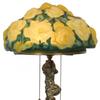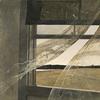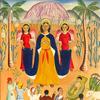Zimmerli Art Museum at Rutgers Acquires the Whole of the Legendary Dodge Collection of Soviet Nonconformist Art
- NEW BRUNSWICK, New Jersey
- /
- November 09, 2017
$44 Million Donation of Historic Artworks from Nancy Ruyle Dodge and Endowment from the Avenir Foundation Includes Largest Single Gift in Rutgers History
A groundbreaking collection of Soviet nonconformist art has been donated in its entirety to the Jane Voorhees Zimmerli Art Museum at Rutgers University-New Brunswick, the university announced today.
The donation by Nancy and Norton Dodge, the largest single gift in Rutgers’ history, makes the museum the world’s principal site for studying and exhibiting the most vital, diverse, and daring strains of art produced throughout the USSR over four decades, said Thomas Sokolowski, director of the Zimmerli, and Nevin Kessler, president of the Rutgers University Foundation.
Nancy Ruyle Dodge has made the promised gift to the Zimmerli of her personal collection of more than 17,300 artworks in all media, with an estimated value of more than $34 million. These objects join the now-legendary body of some 4,000 Soviet nonconformist works that Ms. Dodge and her late husband Norton Dodge donated to the Zimmerli in 1991.
Accompanying the gift of art is an endowment of $10 million from the Avenir Foundation. This is the second endowment gift to the Zimmerli from the foundation, which in 2001 helped realize Nancy and Norton Dodge’s vision of global access to their works through exhibitions, publications, conservation and scholarship.
Now permanently united at the Zimmerli, the entire Nancy and Norton Dodge Collection represents the work of more than 1,000 artists active from about 1956 (the year of Nikita Khruschev’s “secret speech” to the 20th Party Congress, denouncing Stalinism and initiating a cultural thaw) through 1991 and the end of the Gorbachev era of glasnost and perestroika. Included among the newly donated works are paintings on canvas and panel, sculptures, assemblages, installations, works on paper, photographs, videos and artists’ books. Extending well beyond Russia in its scope, the collection includes many examples of nonconformist art produced in the Soviet republics of Armenia, Azerbaijan, Belarus, Estonia, Georgia, Kazakhstan, Kyrgyzstan, Latvia, Lithuania, Turkmenistan, Ukraine, and Uzbekistan.
Some works from the new gift are already on view at the Zimmerli in the exhibition Commemorating the Russian Revolution, 1917/2017 (on view through February 18, 2018). While many exhibitions and events are taking place around the world on the 100th anniversary of the Bolshevik Revolution, the Zimmerli’s show is the only one that uses the Dodge collection to view the long aftermath of this upheaval through the eyes of artists who courageously refused the constraints on subject matter and style imposed by the Soviet state.
Deba Dutta, chancellor of Rutgers-New Brunswick, said that with this gift, the Zimmerli becomes unique not only among university art institutions but in the world of museums. “This remarkable gift underscores our university’s cultural and educational value to our global society.”
Sokolowski said the original gift of the Dodge Collection in 1991 immediately made the Zimmerli a global center for this crucial field of art. “It revealed to the public the astonishing and heroic story of the Dodges’ efforts to locate, collect and preserve a vast body of work that was officially not even supposed to exist,” he said. “It is staggering to have the entire collection brought together at last.”
Kessler said Rutgers University Foundation is deeply grateful to Nancy Ruyle Dodge and the Avenir Foundation for their magnificent generosity. “Any institution would have been overjoyed to receive this unparalleled collection of artworks, with the endowment to make them accessible in perpetuity to scholars and the public,” he added. “The choice of Rutgers reaffirms the donors’ longstanding commitment to this university, while testifying to the outstanding work our curators and researchers have done over the years to promote awareness and appreciation of this highly significant artistic legacy.”
Nancy Ruyle Dodge said: “My husband Norton and I felt it was our mission to bring to light these remarkable works that had been consigned to obscurity, and to honor artists of exceptional talent who had been suppressed and defamed. We entrusted Rutgers with an initial gift from the collection because we believed the university deeply understood our goals and had both the scholarly resources and the institutional will to realize our purpose. Now, more than a quarter of a century later, I know our confidence was well placed. I am very pleased to donate the collection in its entirety to Rutgers, as the best and only place for it to reside.”
According to Julia Tulovsky, curator of Russian and Soviet nonconformist art at the Zimmerli, the body of work that has now been gifted to the Zimmerli holds surprises even for art historians who have specialized in this subject. “The type of Russian nonconformist art that came to be known in the West,” she says, “was predominantly from the Sots Art movement, which used the imagery of Communist propaganda to mock the system. Only a few Sots artists, the ones who emigrated to the West, made names for themselves here. But there were others who remained in Russia and produced superb work that is practically unknown in the West. For example, it was a revelation to me to discover Rostislav Lebedev [born in Moscow, 1946] through the newly donated pieces. His art looks more relevant to the political changes in Russia today than do the works of his better-known fellow Sots artists. We have chosen three pieces by him for Commemorating the Russian Revolution 1917/2017.”
Tulovsky points out that the new donation also expands Western knowledge of innovative trends beyond Sots Art. “Leningrad in the 1980s had a vibrant atmosphere,” she said, “where visual arts, cinema and rock music were interconnected. One of the key figures in this landscape was Timur Novikov, who is well represented in the new gift.”
The gift also makes it possible for the Zimmerli to look beyond Russia to the different strains of nonconformist art in other Soviet republics. “The Zimmerli has done an exhibition on Baltic art and has also shown work from Ukraine,” she says. “But now we have the material to enable us to explore the work that was done in the Caucasus, for example, and in Georgia in particular.”
ABOUT RUTGERS UNIVERSITY FOUNDATION
Rutgers University Foundation raises funds to support Rutgers, The State University of New Jersey. The foundation is a 501(c) (3) tax-exempt organization. Learn more at support.rutgers.edu
ABOUT THE ZIMMERLI ART MUSEUM
The Jane Voorhees Zimmerli Art Museum is one of the largest and most distinguished university-based museums in the country. It collects, preserves, researches, and exhibits important works of art to provide the university community and regional, national, and international audiences with direct experience of the visual arts. Scholarly activities make art accessible through exhibitions, publications, and educational programs.
The Zimmerli’s operations, exhibitions, and programs are funded in part by Rutgers, The State University of New Jersey, and income from the Avenir Foundation Endowment and the Andrew W. Mellon Foundation Endowment, among others. Additional support comes from the New Jersey State Council of the Arts and donors, members, and friends of the museum.
Admission is free. The museum is located at 71 Hamilton Street (at George Street) on the College Avenue Campus of Rutgers University in New Brunswick.
The Zimmerli Art Museum is open Tuesday through Friday, 10 a.m. to 4:30 p.m., Saturday and Sunday, noon to 5 p.m., and select first Tuesdays of the month, 10 a.m. to 9 p.m. The museum is closed Mondays and major holidays, as well as the month of August.
For more information, visit the museum’s website www.zimmerlimuseum.rutgers.edu or call 848.932.7237.









100x100_c.jpg)




